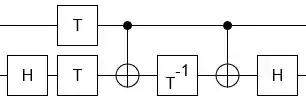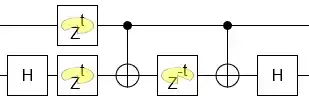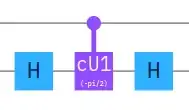I already know how to do that for Z, Y, and H gates. How can I make a controlled sqrt-of-NOT gate? I mean the controlled version of the gate described here.
3 Answers
Here's one decomposition:
It was made by decomposing a controlled S (which is easier to think about because it only phases; it's diagonal) and then converting the basis of the target by conjugating with Hadamards.
It generalizes in-place to any $\text{CNOT}^{2t}$:
- 44,299
- 1
- 41
- 116
I cannot add a comment, but I have a little question to the answer, sorry.
Why exactly $-\pi/2$ (with minus) is a parameter of the cU1 gate in your circuit? Isn't e.g. $\pi/2$ (without minus) appropriate?
- 15,244
- 4
- 32
- 75
- 306
- 1
- 9
If take e.g. this decomposition of the square root of NOT then it's so simple in the IBM Q composer:
And although it is unlikely that this circuit form actually consists of 3 elementary gates (I think the cu1 gate is implemented using 5 elementary ones), in my opinion, it looks just easier than others e.g. from here:
You can also use functions (subroutines) in the composer (like as csx from qelib1.inc), but unfortunately they do not work well any time or work with restrictions.
- 122
- 6



